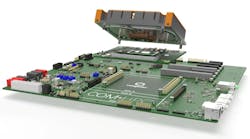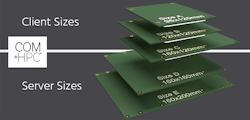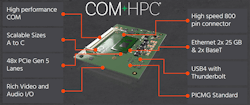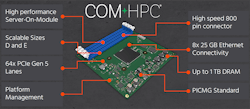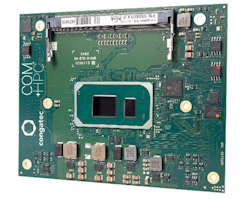>> Electronic Design Resources
.. >> Top Stories of the Week
.. .. >> Embedded World 2021
What you’ll learn:
- What’s in the COM-HPC standard?
- How to get started with COM-HPC.
The COM-HPC standard has now been ratified. And on that front, congatec highlighted its HPC/cTLU COM-HPC client at Embedded World earlier this month.
COM Express is a series of computer-on-module (COM) form-factor standards from PICMG. COM-HPC is just the latest COM targeting high-performance computing (HPC) client and server applications. A COM requires a carrier board to complete a solution, but it has the advantage of putting much of the design complexity in the module. It also allows developers to swap in different modules to provide a variety of power and performance options.
The COM-HPC standard spans five board sizes, addressing client and server implementations (Fig. 1). Clients come in sizes A, B, and C, while servers have the larger D and E form factors. Both utilize high-speed, 800-pin connectors to provide support for PCI Express Gen 5 and USB4, including Thunderbolt support.
The COM-HPC client supports 48 PCIe Gen 5 lanes (Fig. 2). It can provide up to a pair of 25-Gb Ethernet ports plus the ability to support up to four high-end video displays and high-quality audio. The form factor is able to work with the latest 11th-generation Intel Core processors.
The server boards have space for DIMM sockets that can handle up to 1 TB of memory (Fig. 3). They can support up to 64 PCIe Gen 5 lanes and eight 25-Gb Ethernet ports. Platform management also is included in the standard.
Getting Started with COM-HPC
congatec’s COM-HPC starter kit includes its HPC/cTLU COM-HPC client module (Fig. 4). The module is based on Intel’s four-core, Core UP3 processor with a TDP from 12 to 28 W. The Intel Gen 12 Graphics can handle up to four independent 4k60p displays.
The module includes a 4x PCIe Gen 4 and an 8x PCIe Gen 3 interface. Two USB 4.0 ports and two USB 3.2 Gen 2 ports are in the mix as well. The two memory slots support a total of 64 GB of DDR4-3200 memory. The two 2.5-Gb Ethernet ports support time-sensitive networking (TSN).
The boards are designed for industrial and embedded applications. Extended temperature versions are available.
